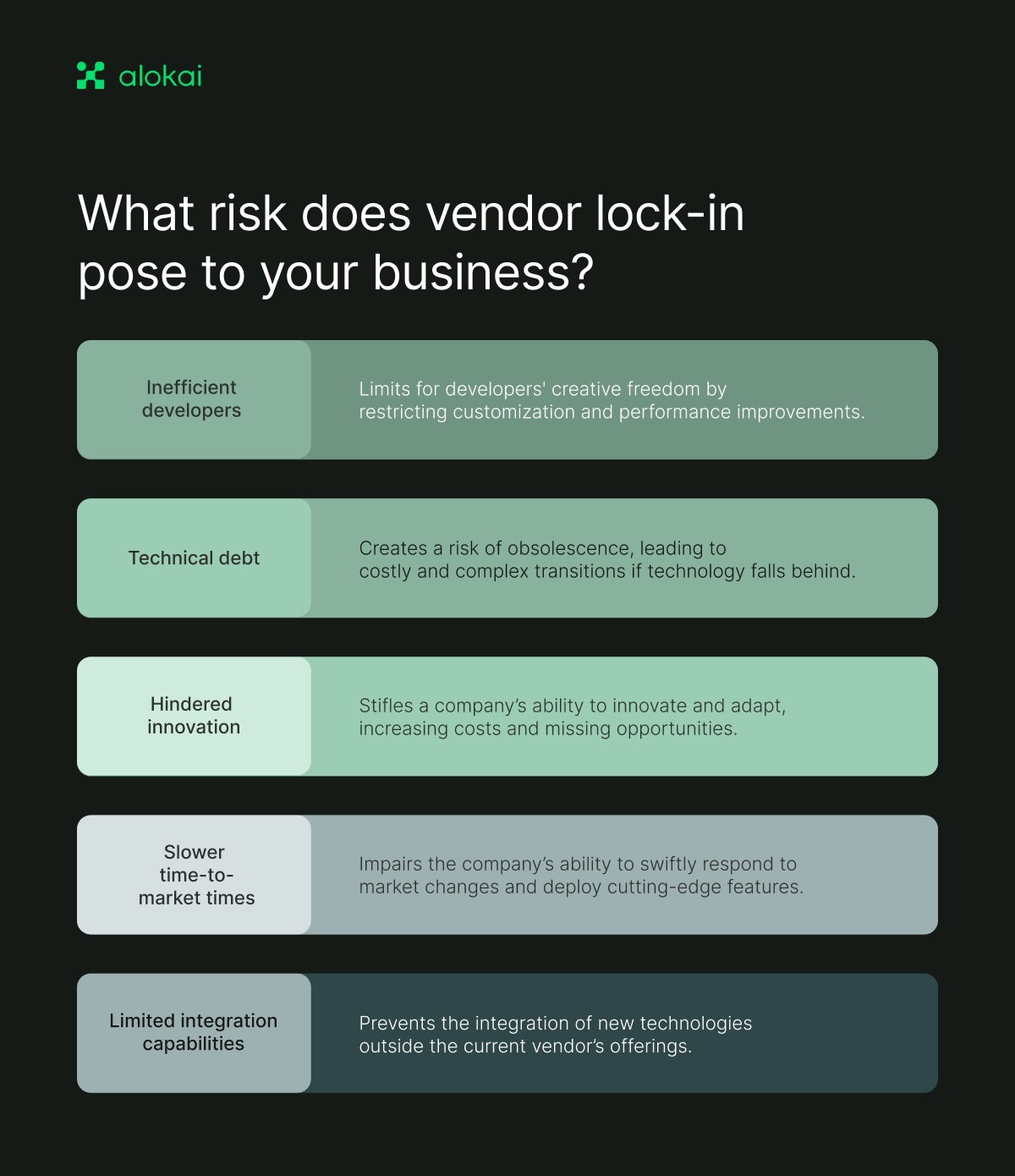Vendor lock-in can feel like being stuck in a tight spot, with high costs to switch and little room for new ideas. This article simplifies the issue, giving practical advice for businesses wanting to avoid or break free from it. Learn the clear steps to make your business more flexible and take control of your tech choices, giving you an edge in today’s fast-changing markets.
Key takeaways
- Vendor lock-in raises costs, limits access to updates and security patches, reduces control over data and features, discourages cloud adoption, and can lead to worse service quality.
- Frontend vendor lock-in limits developer freedom, stifles innovation, increases the risk of outdated technology, and can negatively impact time-to-market and cost efficiency.
- Using open-source technologies, following cloud-neutral practices, and developing a multi-vendor strategy with exit plans can improve flexibility, control, and adaptability, helping you avoid the downsides of vendor lock-in.
What is vendor lock-in and understanding its implications
Vendor lock-in is like a commercial trap that ties a company to a vendor's products and services, making it as hard to escape as finding your way out of a maze. To avoid vendor lock-in, it's important to understand the consequences: higher costs, the risk of losing data or features, and a lot of time and effort needed to switch to other options.
Think of it as being tied down by countless small strings of licensing agreements and technical barriers, which drain resources and block access to important updates and security patches. This issue is common, with 80 percent of businesses worried about the risks of vendor lock-in.
These problems can include sudden price hikes, lower service quality, and legal and technical hurdles that make switching difficult. This dependency can discourage cloud computing adoption because a lack of standardization makes it hard to work with different systems. Imagine a retailer stuck with old systems, unable to seize new opportunities or adapt to market changes – that's the impact of lock-in.
The risks of frontend vendor lock-in

Frontend vendor lock-in is particularly harmful, greatly limiting developers' creative freedom by restricting their ability to customize and improve performance or scalability. Imagine a racing team forced to use an engine from only one manufacturer, regardless of the track conditions – that’s the dilemma of frontend lock-in. The risks don’t end there; relying on a single provider for frontend solutions can create a ticking time bomb of obsolescence, putting businesses in a tough spot when they need to make costly and complex transitions if the technology falls behind.
This stranglehold stifles a company’s ability to innovate and adapt, leading to increased costs and missed opportunities. It’s like a tree planted in a pot too small; its growth is limited, and the potential to reach the skies is curtailed by the confines of its container. The consequences are not just theoretical; they translate to real setbacks in a company’s quest for market leadership.
Impact on innovation and time-to-market
Vendor-locked frontends are the kryptonite to innovation, preventing the integration of new technologies outside the current vendor’s offerings. Imagine a painter with only half a palette of colors – the resulting artwork is inevitably limited. Similarly, developers constrained by lock-in cannot fully harness new technologies, impairing the company’s ability to swiftly respond to market changes and deploy cutting-edge features.
In the early stages of technology’s lifecycle, adapting and adopting new methods is crucial. However, a locked-in frontend is like a ship with its sails tied down, unable to catch the winds of change and sail towards market opportunities. It’s not just about keeping up; it’s about leading in a fast-changing digital marketplace.
Costs and obsolescence risks
The financial impact of vendor lock-in is like a minefield of hidden charges. Sunk costs in existing systems, high expenses in replacing outdated technology, and vulnerability to price exploitation by vendors – these are the dangers businesses face in the lock-in trap. Initial savings from choosing a single vendor can quickly disappear due to long-term contracts and rising prices.
However, there is hope. Moving from proprietary systems to open-source technologies can significantly reduce licensing fees and ongoing maintenance costs. Imagine a business shedding the heavy armor of outdated systems and stepping into the agile attire of modern, cost-effective solutions – that’s the promise of moving away from lock-in.
Embracing flexibility: A frontend without vendor lock-in
A frontend free from vendor lock-in restrictions offers a plethora of possibilities. It bestows businesses with the flexibility to innovate with new tools and can lead to cost savings unshackled from a single vendor’s pricing whims. It’s like a chef who can source ingredients from multiple suppliers, ensuring not only the best quality but also the best price. To avoid vendor lock in, companies should reduce the risk of dependency, which in turn can stifle a company’s ability to innovate and scale due to unilateral pricing and policy changes.
Reaching such agility necessitates adherence to best practices that are not cloud-dependent, using open-source software, and choosing cloud-neutral technologies. This approach ensures that retailers can choose alternatives without penalties, akin to a traveler who can switch flights freely without incurring significant fees, ensuring they are always in control of their journey.
Advantages of open-source technologies
Open-source technologies are a great way to fight vendor lock-in. By using these technologies, companies can make it easier to switch to a new provider. Open-source frontend technologies allow developers to build applications without being restricted by proprietary constraints, creating an environment where innovation can flourish. It’s like being given a blank canvas to paint your own masterpiece instead of following a paint-by-numbers kit.
Additionally, the strong open-source communities that come with these technologies, such as the one Alokai has, offer support and shared expertise. This helps businesses stay up-to-date with the latest advancements and fully utilize new technologies.
Strategic adaptability for evolving needs
A successful business is one that can adapt to changing market demands. Using open standards platforms for frontend development helps maintain independence and reduces reliance on vendor-controlled proprietary technologies. It’s like a chameleon changing its colors to blend in with its surroundings, ensuring survival and success. Hybrid and multi-cloud solutions add another layer of adaptability, letting businesses choose the best services from various cloud vendors without being tied to one provider.
Breaking free from frontend vendor lock-in not only offers strategic benefits but also saves money. Businesses can pick more cost-effective options from a variety of vendors, trimming unnecessary expenses. This approach keeps them agile, responsive, and financially smart in a constantly changing world.
Composable commerce: The antidote to vendor lock-in
Composable commerce is a powerful way to avoid the problems of vendor lock-in. It allows businesses to build custom e-commerce solutions by choosing and combining different independent parts. Think of it like a child playing with building blocks, where each piece adds something unique to the overall creation. Composable commerce uses an API-first, headless architecture, giving retailers a tech stack that they can customize without being tied to any one vendor.
Imagine a marketplace where each stall offers different products, and you can pick and choose what you want – that's the idea behind composable commerce. It breaks down the big, rigid systems of the past and offers a more flexible and tailored approach to e-commerce.
What is composable commerce?
Composable commerce follows the MACH architecture, which stands for:
- Microservices
- API-First
- Cloud-Native
- Headless
This setup means each part of the e-commerce platform works independently, making it easy to integrate and scale. Composable commerce divides features into packaged business capabilities (PBCs), which are often third-party software components that can be added or removed as needed.
This approach is not just about technology; it's about being flexible, scalable, and able to change direction as the market demands. It's like an ecosystem where each part contributes to a stronger whole.
Vendor flexibility with composable commerce
Composable commerce naturally avoids vendor lock-in because it lets you mix and match parts from different vendors as needed. It's like a DJ mixing different tracks to create the perfect playlist. This flexibility allows businesses to choose vendors based on their current needs and easily switch out parts with minimal disruption.
The modular nature of composable commerce supports quick adaptation and keeps businesses agile. They can use plug-and-play components (PBCs) to meet market demands without being held back by tightly coupled services. It's like an orchestra where each musician can play solo or as part of the group, creating a performance that fits the audience's changing tastes.
Crafting a multi-vendor strategy
A good multi-vendor strategy is like a master chef's recipe, combining the best ingredients from different sources to create a better dish. By negotiating contracts with exit strategies and short lock-in periods, businesses can stay flexible and avoid high costs when switching vendors. A multi-cloud and hybrid cloud approach further strengthens this strategy, reducing vendor lock-in and improving data security.
This strategy isn't static; it requires:
- Regularly checking vendor performance and costs
- Actively looking for better solutions
- Choosing vendors committed to technological advancement and innovation
It's an ongoing process, ensuring the business remains agile and ready to seize new opportunities or respond to market changes.
Evaluating cloud providers for maximum flexibility
Choosing the right cloud providers is key to staying flexible. Look for providers that follow industry standards, have a good reputation, and show a clear path for future technology. Think of it like picking a travel buddy who can handle both current and future trips. To avoid getting stuck with one vendor, focus on portability, steer clear of proprietary formats, and consider using multiple clouds.
Providers like Alokai Cloud are great examples. They offer features like scalable cloud services, strong content delivery networks, advanced security (like geofencing and DDoS protection), automatic daily backups, multi-regional deployment, and efficient auto deployment.
These features help Alokai Cloud support global growth, reduce data loss risks, and provide a flexible cloud solution.
Incorporating hybrid and multi-cloud approaches
Using hybrid and multi-cloud strategies is like diversifying your investments. By using services from multiple cloud providers, you enhance flexibility and reduce reliance on any single vendor. This approach protects your business from unexpected issues with one provider.
Retailers using composable commerce can benefit from a multi-cloud strategy by reducing dependence on a single provider, protecting data, and gaining more control. With hybrid or multi-cloud strategies, businesses can store some data on-premises or in a private cloud, ensuring a strong and flexible cloud environment. This strategy puts the business in control, ready to adapt to market changes.
Implementing an exit strategy
In terms of vendor relationships, an exit strategy is like having a lifeboat on a ship – essential for a safe departure if things go wrong. Reviewing contracts with cloud providers to understand how to end the agreement and get your data back is crucial for a smooth transition away from vendors if needed. Testing a migration in a controlled environment should be part of this plan to ensure everything goes smoothly when the time comes.

Key parts of an exit plan
An effective exit plan helps a business navigate the tricky process of changing vendors. Ensuring data can be easily moved by keeping it in widely used formats is key to avoiding vendor lock-in. Keeping internal backups of all data prepares a business to switch hosting if needed, offering protection from vendor lock-in. It’s about being ready to move towards the company’s goals no matter the situation.
Addressing risks like provider outages or changes in legal requirements is also crucial for a planned cloud exit strategy. It’s about being prepared for the unexpected, ensuring that the business stays operational even when external factors change.
Switching vendors smoothly
Switching to a new provider can be risky, like walking a tightrope without safety measures. Data loss during migration is a big concern, often causing businesses to stick with outdated vendors out of fear. To switch vendors smoothly, a business should use multicloud and composable approaches that enhance disaster recovery and business continuity plans. It’s about creating a strong framework that can handle change, ensuring a smooth transition that keeps the business running when switching providers.
By planning for this mobility, businesses can move data and services between providers easily. It’s like a well-rehearsed dance, where each step is in sync to switch positions seamlessly. By preparing for this, businesses can change providers without missing a beat, maintaining uninterrupted service to their customers and staying ahead in the market.
Summary
In the complicated world of digital commerce, vendor lock-in is like a tricky maze that businesses need to escape to thrive. From understanding its challenges to using open-source technologies, and from adopting composable commerce to creating a strong multi-vendor strategy, this guide shows you how to avoid getting stuck. With a solid exit plan, businesses can stay flexible, innovative, and in control of their future. Follow these steps, and your business can enjoy the freedom and flexibility to grow and succeed.













